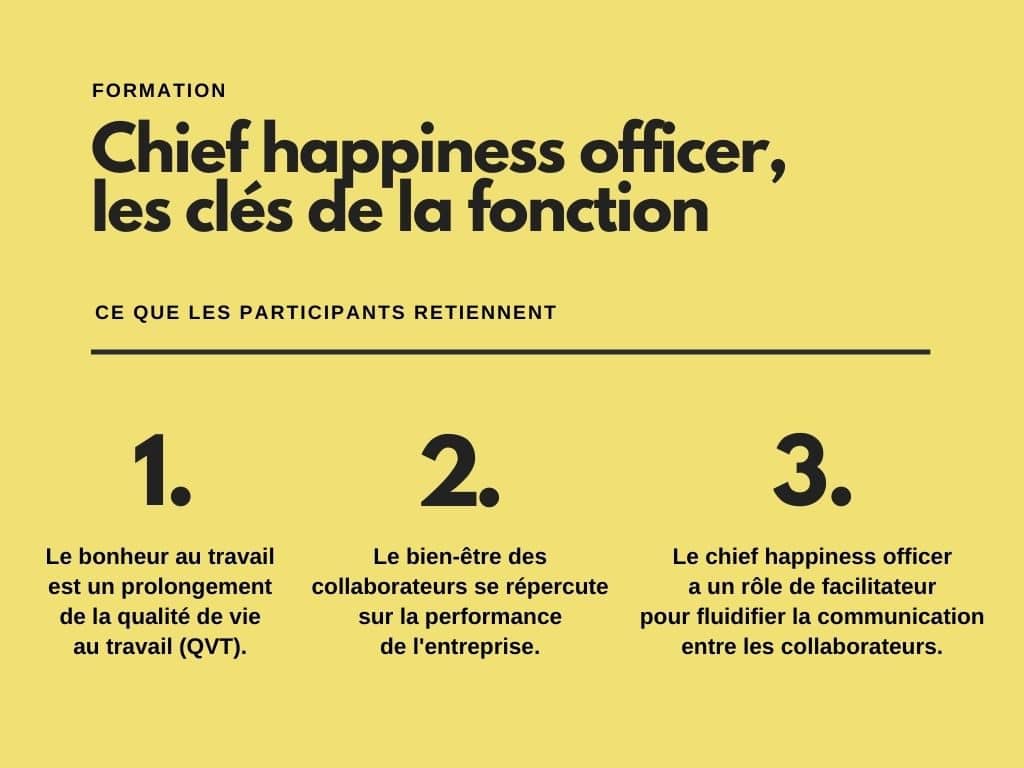At a time when companies are seeking a new equilibrium by projecting themselves into the "post COVID-19 world", the chief happiness officer (CHO) has a more important role to play than ever before. role teleworking has a crucial role to play in improving quality of life at work. With the spread of teleworking, preventing isolation and psychosocial risks, and maintaining a sense of belonging are taking on a new dimension within companies. By investing in these areas, the CHO function is gaining in maturity and legitimacy. Isabelle Morin, trainer and coach, sheds light on this development.

Is the new role of chief happiness officer already undergoing (r)evolution? The move to teleworking, in response to the health crisis, and the continued use of this organisational model, have led to a change in the profession. The trend is towards the development of a strong HR dimension, and even of a "human resources" dimension. mixed mission between communication and HR.
There has also been a semantic shift in job titles. For example, the terms "internal organisation and communication manager" or "employee experience manager" are tending to replace the title of CHO in some companies. Could this be a sign of recognition for a profession that was much maligned in its early days?
In the early 2000s, it seemed that only start-ups were interested in this function. Then it was the turn of the major international groups to make it part of their HR dynamic. Today, CHOs can be found in all types of companies and business sectors, in both in-house and outsourced positions. The CHO function is on the road to maturity. Day by day, it is acquiring greater legitimacy in HR terms as well as to all employees.
What is a Chief Happiness Officer?
The chief happiness officer contributes to the well-being of the company's employees. But there's more to his or her role than simply installing a table football table and proclaiming that everyone is feeling better at work. The happy washing has shown its limitations.
The CHO's main objective? To set up a caring support for employees, both individually and collectivelyin their professional and personal lives. It's a win-win situation. Employees feel better about their lives, so they can give their best at work, which means they perform better for the company.
Today, the Chief Happiness Officer is committed to an in-depth, high-quality approach that encompasses :
- prevention of psychosocial risks ;
- quality of life at work (QWL);
- corporate social responsibility (CSR) ;
- developing the employer brand ;
- managerial innovation.
Depending on their professional background and the scope of their mission, current and future CHOs may experience training needs. For example :
- Chief happiness officer, the keys to the job ;
- Psychosocial risks: implementing a preventive approach ;
- Developing quality of life at work ;
- CSR communication: enhancing your company's image ;
- Building and developing your employer brand.
Chief happiness officer: changing roles
The Chief Happiness Officer's mission is proving to be crucial in the situation we have been in since March 2020. The CHO first had to adapt to "100 % teleworking" during the first lockdown. Then, in a second phase, to the widespread use of a so-called "hybrid" work organisation. In other words, alternating between teleworking and working on site. Today, it is at the forefront of :
- ensure that links are maintained within the work collective;
- work to prevent the risks associated with the isolation of remote employees;
- facilitate the integration of new employees in the event of a change of employer.on boarding remotely ;
- facilitate work/life balance ;
- giving meaning and motivation back at work...
In short, the chief happiness officer contributes to the retaining talent and therefore to the decrease in turnover.
What are the company's views on this development?
Companies may be particularly keen to respond to the aspirations of their employees and, more broadly, to adapt to new trends in the labour market. In other words, to bring together several different ways of working in a hybrid format.
Here again, the Chief Happiness Officer plays a central role in supporting the company and its employees in implementing this new organisation. He or she intervenes above all as a facilitator to make communication more fluid between employees who have been away from each other and their workplace for many months. It also works to maintaining a sense of belonging employees who are always geographically distant.
Is it possible to be a remote CHO?
In view of their relational role, CHOs should carry out their duties as much as possible in person, so that they are accessible to on-site employees, while remaining attentive to remote employees. A CHO who has to telework part of the time can take advantage of these days to make progress on fundamental projects and to make contact with other teleworkers (interviews, meetings).
As a CHO, how do you adapt your actions in a hybrid working environment?
Faced with Ln response to the health crisis, Chief Happiness Officers have adapted their practices and actions in a number of areas.
Freeing employees from their personal preoccupations
Employees continue to favour solutions that free them from personal preoccupations, allowing them to feel more at ease and devote their attention to their work.
As Christophe Plantin, an executive at Bouygues Télécom, can testify: "I really appreciate having a hairdresser on the company premises. It's really handy to be able to squeeze in a haircut between two meetings. It frees my mind, I feel better and... I work better!
Happiness at work is resolutely at the crossroads of the personal and professional fields. In a hybrid organisation, days on site are opportunities to continue to take advantage of the services offered by certain companies: gym, concierge service (dry cleaners, shoemakers, etc.), company crèche, delivery of vegetables or bread, beauty treatments, etc.
Facilitating cross-functionality and links between employees
Other actions undertaken by the CHO aim to make life easier at work, in particular by fostering links between employees. These include :
- the design of break rooms;
- the organisation of team building ;
- cross-functionality. They can, for example, organise and lead working groups to facilitate communication between departments;
- creativity, which it can encourage via the layout of workspaces (meeting rooms with magnetic walls, etc.).
The Chief Happiness Officer also has to be imaginative in proposing activities that respect health regulations and individual sensibilities. These constraints create an opportunity to change habits! In other words, the chief happiness officer must think outside the box and develop your creativity.
It's a new and fast-moving profession, so it's time for training!
Just because they are sometimes referred to as "happiness managers" does not mean that chief happiness officers decide on the happiness of others. He or she is first and foremost a facilitator who encourages employees to improve their quality of life, both at work and in their work/life balance. To achieve this, they draw on their communication, mediation and organisational skills as well as their soft skills such as altruism, interpersonal skills, ability to bring people together, enthusiasm, listening skills, adaptability and creativity.
This is a new and fast-changing profession. That's why both practising professionals and candidates for the job benefit from developing their skills and exchanging ideas with their peers. via dedicated training courses.
Training Chief happiness officer, the keys to the job addresses cross-functional key points such as QWL, company performance and communication.
This course enables participants to take a step back and place their role in a broader context. By adding more value to their actions, they will be better able to establish their vision within the company. For them, it's also an opportunity to draw up a diagnosis and define an action plan. The training enables them to renew their toolbox: they leave reboosted, with new ideas to implement.

The advantages of chief happiness officer training
When they attend training sessions, participants particularly appreciate the peer-to-peer exchanges, the opportunity to take a step back from their jobs, the sharing of best practice and the feedback from HR. At least, that's what my training colleagues and I observe during the sessions.
In conclusion, I would like to address all current and future Chief Happiness Officers. Take advantage of this excellent opportunity offered by the perpetuation of teleworking and the introduction of the hybrid organisation to develop your function for the benefit of all!


